Ragtime, Lynn Ahrens and Stephen Flaherty’s musicalized version of E. L. Doctorow’s novel about a quickly changing America at the turn of the 20th century, has received a new concept, which is currently playing to enthusiastic audiences at the Pasadena Playhouse. The last time Ragtime was revived on Broadway was in 2009, a production whose accouterments were stripped bare, leaving almost everything to the imagination. Ragtime has always been an expensive show to put on. Despite rave reviews and four Tony awards, the producers of the original Broadway run were forced to shut down due to the “unwieldy cost” of putting on the show, after only two years and 861 performances. The ornate pageantry of the production, which required 160 employees for every performance and a weekly cost of $530,000 was just too much of a burden to bear any longer. Losing the Best Musical Tony to The Lion King didn’t help matters any so Ragtime closed two days before its second anniversary. It could have run much longer.
When it finally came time for its first revival a decade later, the decision was made to discard the show’s opulent sets and reduce the cast size from 49 to 34. Patrons who saw the 2009 revival arrived to find a bare bones set consisting of scaffolding and only the suggestion of the time it took place. Even Coalhouse Walker Jr.’s piano and automobile received abstract, skeletal representation. But with all the cost-cutting, that staging of Ragtime lasted a mere 65 performances, another victim to the high cost of staging elaborate musicals with multiple sets and a large cast. There have been no attempts to revive the show since.
Last year, director David Lee came up with an idea that threatened to anger Broadway traditionalists by totally revising Ragtime’s look, much as Matt Kinley did for the 2014 revival of Les Miserables, when the ubiquitous rotating turntable used to shuttle actors and set pieces on and off stage was jettisoned. Lee’s idea was to set the story in the warehouse of a national historical museum. As the show begins, we see dozens of packing crates stacked all around the stage, creating a labyrinth of passageways and ladders from which cast members could enter and exit. Edgar, the little boy, as always, announces the time and the setting, but instead of joining the cast members in the famous Prologue, he sits down on the floor and watches as the characters emerge from the bowels of the warehouse to perform the show’s title song. Instead of circling one another in the show’s familiar staging, the three groups: Mother and Father’s privileged upper-middle-class suburban family, Coalhouse Walker’s cadre of high-stepping African Americans, and Tateh’s bedraggled immigrants, mingle with one another in a metaphorically integrated social cakewalk.

In the original Prologue, the characters famously freeze while circling each other, responding to the music’s stoptime arrangement. Lee changed this by employing a simple device: a game of musical chairs. In Lee’s version, the characters march warily around a row of chairs which are removed, one by one, in each successive stoptime freeze, just like the game we all played at birthday parties when we were young. At the end of the last round, only the white characters gain seats, leaving out the African Americans and the immigrants, a metaphor about the times that simply did not exist in the original concept of the scene. Huge plaudits to Lee for coming up with this brilliant idea.
The startling reimagining of the Prologue is unnerving to one who is familiar with the show, but rest assured, there is no disruption of Terrence McNally’s brilliant adaptation of Doctorow’s novel, since Ragtime is locked in its own time frame, thanks to the existence of its period “celebrity” characters: Harry Houdini, Booker T. Washington, Emma Goldman, Henry Ford, J. P. Morgan, and Evelyn Nesbit.
Tom Buderwitz’s scenic design utilizes the packing crates in ingenious ways throughout the show; serving as screens for numerous projections and even concealing characters (Nesbit and Houdini), who pop out of crates instead of making more conventional entrances. There’s even a delightful moment when a disembodied hand is thrust out of one of the crates to hand Houdini a hat. Henry Ford and J. P. Morgan’s initial appearances are not live, but as filmed images. In Act II, a giant screen is lowered to view vintage newsreel movies of Atlantic City.
The crates symbolize the memories stored within our history that are exposed as the show takes shape. Themes of bigotry, the subservient roles women played in society, ill treatment of immigrants, and the increasing disparity between rich and poor are all elements of Ragtime that still exist today. The message is that we must look to the past to recognize that what goes around comes around, and the packing crate metaphor works better than any other tableaus we’ve seen over the years in the various productions of Ragtime. We’ve buried these memories of the way America used to be, but in order to learn from our mistakes, we must not seal these memories away forever. Periodically, they must be uncrated and reexamined in the light of modern society.
The performances in this production are universally outstanding, led by two of Ventura County’s more familiar and respected performers: Shannon Warne, a radiant and elegant Mother, and Marc Ginsburg as Tateh, the Latvian Jew who arrives in America to seek his fortune.
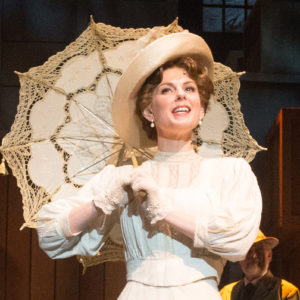
With her husband (Zachary Ford) away on a North Pole expedition with Admiral Perry, Mother is forced to make life-and-death decisions on her own, as she rescues an abandoned African American infant who was buried alive in her flower garden. The moment she realizes the power that she holds in determining not just the future of the child but her own, is exquisitely portrayed by Warne, with a soaring voice on the score’s larger-than-life ballads, “Journey On,” “What Kind of Woman,” and especially, an emotionally rich rendition of “Back to Before.”
Ginsburg is one of those rare actors who can effectively play character roles as well as leading men, and Tateh gives him the opportunity to do exhibit both elements of his talents. His anguish when faced with the demeaning attitudes faced by immigrants is heartbreaking, but Ginsburg just as easily slips into the wistful “Gliding” and Tateh’s alter ego as “Baron Ashkenazy,” the expansive director of the nascent movie industry.

Clifton Duncan’s Coalhouse Walker Jr. is played as somewhat less than a larger-than-life figure; Duncan plays Walker more subdued and thoughtful, which makes the character more believable, able to intone the lovely “Sarah Brown Eyes” with as much believability as in the torment of “Coalhouse’s Soliloquy.” In fact, the grandiose volume of the more sweeping songs have all been taken down a notch, from operatic fortissimo to a more melodic mezzo forte. In Lee’s production, the show’s emotional musical apogees: “Back to Before,” “Your Daddy’s Son,” and “Make Them Hear You,” don’t reach the rafters, but hover seductively over the audience. Ragtime is still a big show, but its most strident songs don’t overwhelm us, which is a refreshing change, allowing us to appreciate the melodic beauty of Flaherty’s music.
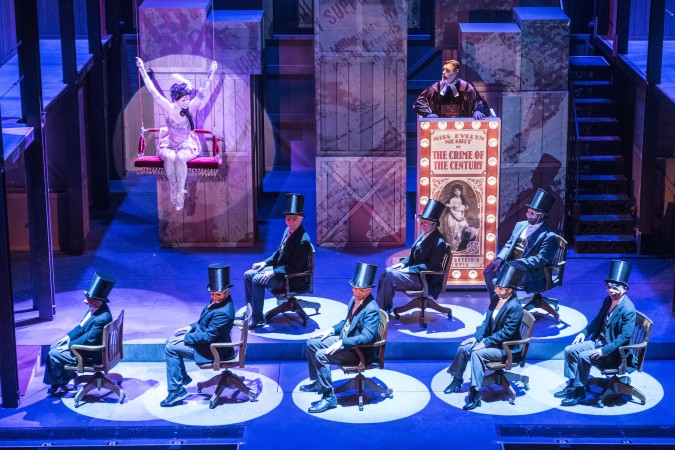
The character of Evelyn Nesbit has been drastically changed, due to additional research into what Nesbit was really like. No longer the vacuous Kardashian-like bimbo, Nesbit, as played by the excellent Katharine McDonough, is now a calculating publicity seeker who knows exactly what she’s doing when she takes advantage of the murder of architect Stanford White by her unstable husband, Harry K. Thaw to exploit her newfound celebrity.
Dylan Saunders crafts Younger Brother’s personality into the prototype of a modern day loner/terrorist, who finds no way to fit into society except to join Walker’s vigilante gang. Bryce Charles is wonderful as Walker’s beloved Sarah; her soliloquy, “Your Daddy’s Son,” is alternately moving and anguished, one of the finer solo moments in the show.
Zachary Ford gives the character of Father the ambiguity needed to portray a basically good man who is discovering that his preconceived notions of women and minorities’ places in society are changing. His solo on the hauntingly lovely “New Music,” in which ragtime music serves as a metaphor for his changing world, is superbly effective.
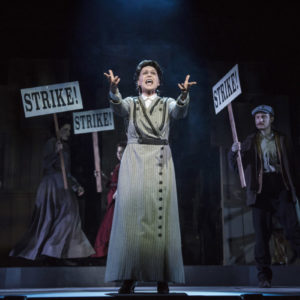
The historical characters are all outstandingly cast, especially Benjamin Schrader, a dead-ringer for Harry Houdini, Valerie Perri as the anarchist Emma Goldman, and Dedrick Bonner as a larger-than-life Booker T. Washington. The two children, Luke Barbato Smith as the clairvoyant Edgar (inspired by psychic Edgar Cayce, who actually forewarned the real Houdini about the Archduke Franz Ferdinand’s assassination, which triggered World War I) and Iara Nemirovsky, as Tateh’s timid daughter, also give excellent performances.
The cast size has been further reduced to 20, with all actors playing multiple roles during the production. Of note in this category is Gregory North, who plays the crusty Grandfather as well as a train conductor and various other smaller roles. Coalhouse’s gang has now been reduced to a single henchman, played by Cornelius Jones Jr.
Darryl Archibald led the sizable 16-piece orchestra. The outstanding costumes were designed by Kate Bergh. The packing crates proved to be a challenge for any lighting designer, but Jared A. Sayeg knew exactly how to handle it, producing moody, subdued lighting that accentuated the shadows cast by the crates.
If you’re already familiar with Ragtime, you will be witnessing this extraordinary production as if you were seeing it for the first time. The show’s run has been extended until March 9. It is highly recommended. For tickets, visit www.pasadenaplayhouse.org



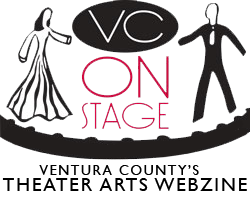
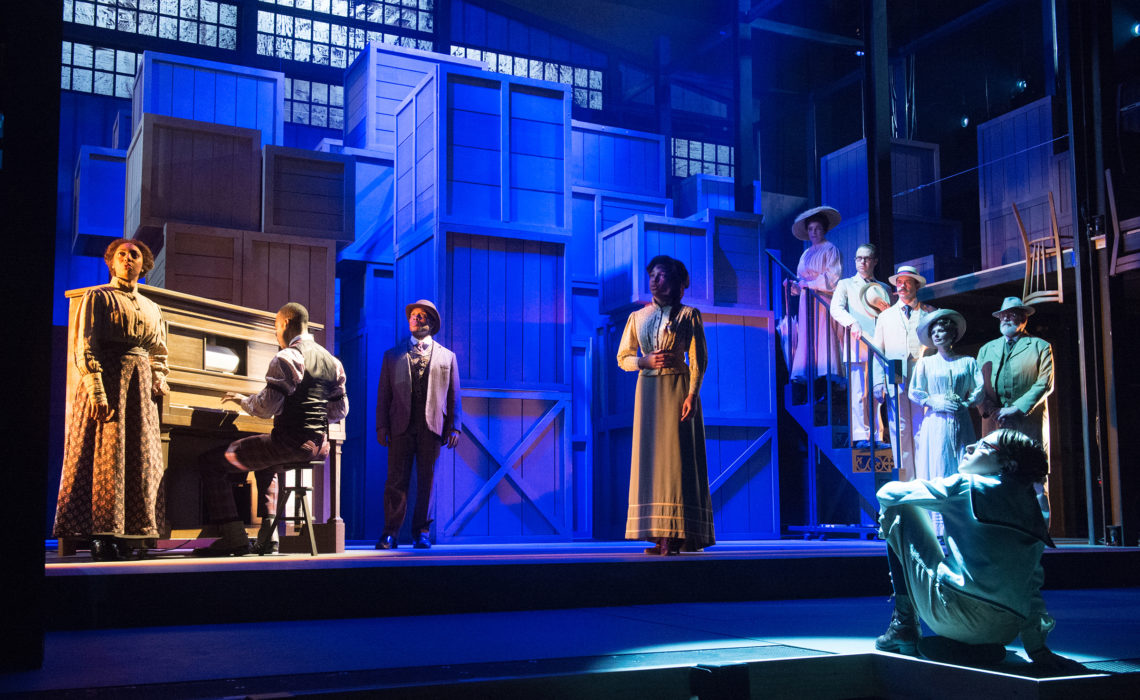

No Comments